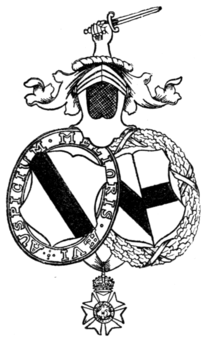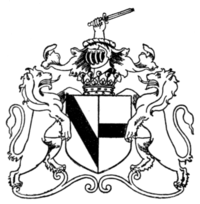presumptive) a marriage with any woman who is an heir or coheir results in her arms being placed upon an escutcheon of pretence over the arms of the husband. In the cases of all other women the arms are "impaled" only. To "impale two coats" the shield is divided by a straight line down the centre, the whole design of the arms of the husband being placed on the dexter side of the escutcheon, and the whole design of the wife's arms being placed on the sinister side (Fig. 742).
It may perhaps be as well to here exemplify the different methods of the conjunction of the arms of man and wife, arranging the same two coats in the different methods in which they might be marshalled before reverting to ancient practices.
An ordinary commoner impales his wife's arms as in Fig. 742. If she be an heiress, he places them on an escutcheon of pretence as in Fig. 743. If the husband, not being a Knight, is, however, a Companion of an Order of Knighthood, this does not (except in the case of the Commanders of the Victorian Order) give him the right to use the circle of his Order round his arms, and his badge is simply hung below the escutcheon, the arms of the wife being impaled or placed on an escutcheon of pretence thereupon as the case may necessitate. The wife of a Knight Bachelor shares the state and rank with her husband, and the only difference is in the helmet (Fig. 744). But if the husband be a knight of any order, the ensigns of that order are personal to himself, and cannot be shared with his wife, and consequently two shields are employed. On the dexter shield are the arms of the husband with the circle of his order of knighthood, and on the sinister shield are the arms of the husband impaling the arms of the wife. Some meaningless decoration, usually a wreath of oak-leaves, is placed round the sinister shield to "balance," from the artistic point, the


